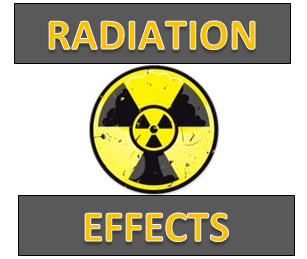Radiation Effects
Every inhabitant on this planet constantly exposed to naturally occurring ionizing radiation called background radiation. Sources of background radiation include cosmic rays from the sun and stars, naturally occurring radioactive materials in rocks and soil, radio-nuclides normally incorporated into our body's tissues, and radon and its products, which we inhale. We are also exposed to ionizing radiation from man-made sources, mostly through medical procedures like x-ray diagnostics. Radiation therapy is usually targeted only to the affected tissues.

Much of our data on the effects of large doses of radiation comes from survivors of the atomic bombs dropped on Hiroshima and Nagasaki in 1945 and from other people who received large doses of radiation, usually for treatment. Only about 12% of all the cancers that have developed among those survivors are estimated to be related to radiation.
Ionizing radiation can cause important changes in our cells by breaking the electron bonds that hold molecules together. For example, radiation can damage our genetic material (DNA). But the cells also have several mechanisms to repair the damage done to DNA by radiation.
Potential biological effects depend on how much and how fast a radiation dose is received. An acute radiation dose (a large dose delivered during a short period of time) may result in effects which are observable with in a period of hours to weeks. A chronic dose is a relatively small amount of radiation received over a long period of time. The body is better equipped to tolerate a chronic dose than an acute dose as the cells need time to repair themselves.
Radiation effects are also classified in two other ways, namely somatic and genetic effects. Somatic effects appear in the exposed person. The delayed somatic effects have a potential for the development of cancer and cataracts. Acute somatic effects of radiation include skin burns, vomiting, hair loss, temporary sterility or sub-fertility in men, and blood changes. Chronic somatic effects include the development of eye cataracts and cancers. The second class of effects, namely genetic or heritable effects appears in the future generations of the exposed person as a result of radiation damage to the reproductive cells, but risks from genetic effects in humans are given to be considerably smaller than the risks for somatic effects.
Average Acceleration Calculator
Average acceleration is the object's change in speed for a specific given time period. ...
When an object falls into the ground due to planet's own gravitational force is known a...
In Mathematics, the permutation can be explained as the arrangement of objects in a particular order. It is an ordered...
A rectangle can be explained as a 4-sided quadrilateral which contains equal opposite sides. In a rectangle
A three sided polygon which has three vertices and three angles is called a triangle. Equilateral triangle...







